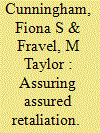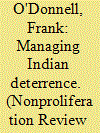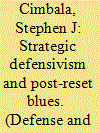|
|
|
Sort Order |
|
|
|
Items / Page
|
|
|
|
|
|
|
| Srl | Item |
| 1 |
ID:
142111


|
|
|
|
|
| Summary/Abstract |
Whether China will abandon its long-standing nuclear strategy of assured retaliation for a first-use posture will be a critical factor in future U.S.-China strategic stability. In the past decade, advances in U.S. strategic capabilities, especially missile defenses and enhanced long-range conventional strike capacity, could undermine China's nuclear retaliatory capability, which is based on a relatively small force and second-strike posture. An exhaustive review of Chinese writings on military affairs indicates, however, that China is unlikely to abandon its current nuclear strategy of assured retaliation. Instead, China will modestly expand its arsenal, increase the sophistication of its forces, and allow limited ambiguity regarding its pledge not to use nuclear weapons first. This limited ambiguity allows China to use the threat of nuclear retaliation to deter a conventional attack on its nuclear arsenal, without significantly increasing the size of its nuclear forces and triggering a costly arms race. Nevertheless, China's effort to maintain its strategy of assured retaliation while avoiding an arms race could backfire. Those efforts increase the risk that nuclear weapons could be used in a crisis between the United States and China, even though China views this possibility as much less likely than the United States does.
|
|
|
|
|
|
|
|
|
|
|
|
|
|
|
|
| 2 |
ID:
167793


|
|
|
|
|
| Summary/Abstract |
India is developing new nuclear force options in response to what it perceives as a deteriorating strategic environment. New Delhi has historically adhered to the nuclear strategic concept of “credible minimum deterrence,” defined as maintaining a small, survivable nuclear force at low readiness in peacetime, which poses a credible risk of nuclear retaliation to adversaries but does not guarantee it. However, India’s stated commitment to credible minimum deterrence is currently challenged by four specific developments: the gradual weakening of elite support for India’s no-first-use policy; the decision of its defense scientific agency to pressure policy makers by publicly announcing it can field tactical nuclear weapons; the shift of Indian Air Force planning toward potential counterforce strikes; and New Delhi’s unclear intentions concerning ballistic-missile defense. This article concludes that India faces a choice between two distinct nuclear-policy pathways: retaining its adherence to credible minimum deterrence, or permitting increasing ambiguity surrounding its true nuclear doctrine and posture. The article evaluates these nuclear-policy options and concludes that credible minimum deterrence remains more consistent with Indian national-security and foreign-policy goals.
|
|
|
|
|
|
|
|
|
|
|
|
|
|
|
|
| 3 |
ID:
128039


|
|
|
|
|
| Publication |
2014.
|
| Summary/Abstract |
US nuclear deterrence and arms control policy may be moving, by design and by inadvertence, toward a posture of strategic "defensivism". Strategic "defensivism" emphasizes the overlapping and reinforcing impact of: (1) reductions in US, Russian and possibly other strategic nuclear forces, possibly down to the level of "minimum deterrence," (2) deployment of improved strategic and/or theater antimissile defenses for the US, NATO allies and other partners; and (3) additional reliance on conventional military forces for some missions hitherto preferentially assigned to nuclear weapons. This article deals with the first two of these aspects only: the interaction between missile defenses and offensive force reductions in US-Russian strategy and policy. The findings are that stable deterrence as between the USA and Russia is possible at lower than New Strategic Arms Reduction Treaty levels, but reductions below 1000 deployed long-range weapons for each state, toward a true minimum deterrent posture, will require multilateral as opposed to bilateral coordination of arms limitations. Missile defenses might provide some denial capability against light attacks by states with small arsenals, but they still fall short of meaningful damage limitation as between powers capable of massive nuclear strikes.
|
|
|
|
|
|
|
|
|
|
|
|
|
|
|
|
| 4 |
ID:
156474


|
|
|
|
|
| Summary/Abstract |
For Korean Peninsula watchers, the two most recent years have been tainted by
further North Korean provocations. Three nuclear tests and a series of missile tests
are signs that the North Korean nuclear crisis has reached a different level. While
talks have focused on deterring the use of nuclear weapons or destroying incoming
missiles using missile defense systems, relatively not much has been discussed
about North Korea’s nuclear strategy and doctrine. To make extended deterrence
against North Korea truly effective and fine-tune our counter–provocation strategy,
we need to think about how North Korea would use its nuclear weapons before
or during a war. One way to gain insight into its strategy is to examine its nuclear
doctrine. Whatever the initial purpose the North Korean leadership had in mind, it
has become clear that it is trying to build a second–strike capability, but whether
its nuclear doctrine is based on an “assured retaliation” or “asymmetric escalation”
strategy is to be watched carefully. North Korea’s reality indicates that an assured
retaliation strategy is more likely. But as its nuclear capability develops, it could aim
to adopt an asymmetric escalation strategy in the long-term. Before they accomplish
that goal, the ROK–U.S. alliance should find an effective means of changing North
Korea’s strategic thinking.
|
|
|
|
|
|
|
|
|
|
|
|
|
|
|
|
|
|
|
|
|